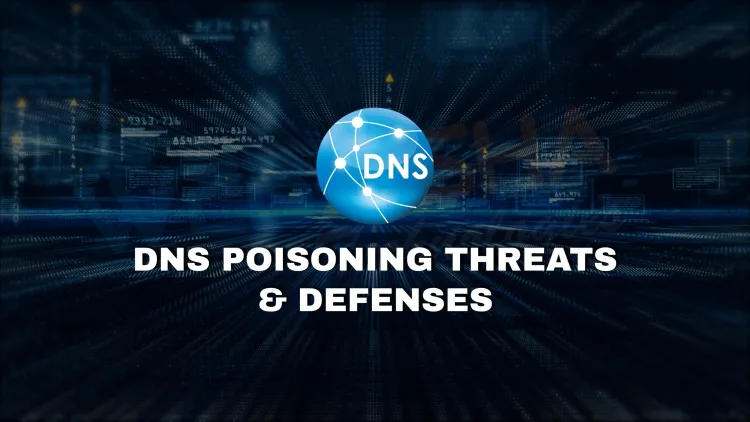DNS Poisoning Attack Explained: How It Works, Risks & Prevention Tips (2025)
Learn what a DNS poisoning (DNS spoofing) attack is, how it redirects users to fake websites, real-world examples, and expert prevention tips. Stay protected in 2025.

Table of Contents
- What Is a DNS Poisoning Attack?
- How DNS Poisoning Works (Step-by-Step)
- Real-Life Example of DNS Poisoning
- Types of DNS Spoofing Techniques
- How to Detect DNS Poisoning
- How to Prevent DNS Poisoning Attacks
- Tools for DNS Security
- Why DNS Poisoning Is Still a Big Threat in 2025
- Conclusion
- Frequently Asked Questions (FAQs)
In the modern world of cybersecurity, one of the most deceptive and dangerous network attacks is DNS Poisoning. Also known as DNS spoofing, this technique is used by attackers to redirect internet traffic from legitimate websites to malicious fake websites — without the user ever knowing.
In this blog, we’ll explore how DNS Poisoning works, how it affects users and organizations, and most importantly, how you can protect your network from these stealthy attacks.
What Is a DNS Poisoning Attack?
DNS (Domain Name System) is like the phonebook of the internet. When you type a website like www.google.com, DNS translates that into a machine-readable IP address like 142.250.193.78.
A DNS poisoning attack manipulates this translation process by inserting false DNS records into the DNS cache. As a result, users are directed to malicious servers instead of legitimate ones.
Example: You type
www.bank.com, but due to DNS poisoning, you are taken to a fake banking website controlled by a hacker — designed to steal your login and banking info.
How DNS Poisoning Works (Step-by-Step)
Step 1: DNS Request
A user opens a browser and types a domain name. The browser sends a request to a DNS resolver to find the matching IP address.
Step 2: Attacker Interferes
The attacker sends a forged DNS response before the legitimate one arrives.
Step 3: Poisoned DNS Cache
If the forged response is accepted first, the resolver saves the malicious IP address in its cache.
Step 4: Redirection to Malicious Site
Any future user requesting the same domain is redirected to the attacker’s phishing or malware-laden website.
Real-Life Example of DNS Poisoning
In 2010, hackers launched a DNS poisoning attack on China's DNS infrastructure, redirecting users to unintended websites. Some visitors trying to access Facebook or Twitter were redirected to propaganda websites.
What Can Hackers Do with DNS Spoofing?
-
Phishing Attacks – Steal usernames, passwords, banking details.
-
Malware Distribution – Install viruses or spyware on user devices.
-
Man-in-the-Middle Attacks – Intercept data during communication.
-
Website Impersonation – Redirect users to fake sites that look exactly like the real ones.
Types of DNS Spoofing Techniques
| Attack Type | Description |
|---|---|
| In-Path Spoofing | Attacker is placed between client and DNS server to intercept requests. |
| Blind Spoofing | Attacker guesses transaction ID and sends fake responses blindly. |
| Cache Poisoning | Alters records in DNS cache, affecting multiple users. |
| Man-in-the-Middle DNS Attack | Attacker listens to DNS traffic and responds with fake IPs. |
How to Detect DNS Poisoning
-
Check for Mismatched IPs – Compare the IP returned from DNS with the official one.
-
Frequent Redirects – Constant redirection to suspicious domains.
-
SSL/TLS Warnings – Fake websites often lack valid HTTPS certificates.
-
Use DNS Monitoring Tools – Tools like
dnstop,dnsquerysniffer, orSplunk DNS dashboardcan help identify suspicious patterns.
✅ How to Prevent DNS Poisoning Attacks
Here are some best practices and configurations to prevent DNS poisoning:
Enable DNSSEC (DNS Security Extensions)
-
Adds digital signatures to DNS responses, verifying their authenticity.
-
Prevents tampering and forged responses.
Disable Recursion on DNS Servers
-
Reduces the risk of attackers using your DNS server as a relay for fake responses.
Shorten DNS Cache TTL
-
Reduce the Time-To-Live (TTL) for cached entries, so poisoned records expire faster.
Use Encrypted DNS (DoH / DoT)
-
DNS over HTTPS (DoH) and DNS over TLS (DoT) encrypt DNS queries and prevent interception.
Keep Systems Updated
-
Patch your DNS software (e.g., BIND, Unbound, Windows DNS) to prevent known vulnerabilities.
Monitor DNS Traffic
-
Use IDS/IPS systems to detect unusual DNS behavior like high query volume or odd IP resolutions.
Tools for DNS Security
| Tool | Use |
|---|---|
| Wireshark | Analyze DNS traffic for spoofed packets |
| dnsspoof | Test your network against DNS spoofing |
| Dig/NSLookup | Verify correct DNS resolution |
| Unbound + DNSSEC | Secure DNS server with DNSSEC support |
| Pi-hole | Blocks unwanted DNS queries and ads |
Why DNS Poisoning Is Still a Big Threat in 2025
Even in 2025, DNS poisoning remains one of the top cyber threats due to its:
-
Low detection rate
-
Ease of exploitation (especially on open or outdated DNS servers)
-
Huge impact — one poisoned record can affect thousands of users
As businesses and consumers continue to rely on DNS-based systems for everything from banking to IoT, protecting DNS is more important than ever.
Conclusion
DNS poisoning is like a hacker changing your map directions — sending you to a trap instead of your real destination. While the technique is old, it’s still widely used due to misconfigured servers, weak security, and poor awareness.
To stay safe:
-
Use DNSSEC
-
Encrypt your DNS traffic
-
Avoid public Wi-Fi for sensitive tasks
-
Monitor and secure your DNS infrastructure
Remember: Your internet starts with DNS—secure it like you would your own home address.
Frequently Asked Questions (FAQs)
What is DNS poisoning?
DNS poisoning is a cyberattack where fake DNS information is inserted into a DNS resolver's cache, redirecting users to malicious websites.
What is another name for DNS poisoning?
It is also known as DNS spoofing.
How does DNS poisoning work?
Attackers send fake DNS responses to a resolver before the legitimate ones, causing it to cache and serve incorrect IP addresses.
Why is DNS poisoning dangerous?
It redirects users to fake websites that can steal passwords, financial information, or install malware.
What is a real-world example of DNS spoofing?
In 2010, Chinese users trying to visit Facebook and Twitter were redirected to propaganda sites via DNS poisoning.
What is the goal of a DNS spoofing attack?
To redirect traffic from legitimate sites to attacker-controlled sites for theft or malware delivery.
What is the impact of DNS poisoning on businesses?
It can result in data breaches, customer distrust, and serious financial loss.
Can DNS poisoning affect home users?
Yes, especially if they use unsecured Wi-Fi networks or compromised routers.
How can I detect if my DNS is being poisoned?
Signs include unexpected redirects, certificate warnings, or differences in DNS responses when queried via multiple sources.
How do attackers execute a DNS spoofing attack?
By sending forged DNS responses with false IP addresses faster than the real response arrives.
Can antivirus software detect DNS poisoning?
Not always. It typically requires DNS traffic monitoring or specific security tools.
What is DNSSEC and how does it help?
DNSSEC (Domain Name System Security Extensions) adds digital signatures to DNS data to ensure it hasn’t been tampered with.
What is cache poisoning in DNS?
It refers to inserting false DNS records into a resolver’s cache to affect multiple users.
What is TTL in DNS and how does it relate to poisoning?
TTL (Time To Live) is how long DNS records are cached. Lower TTL means poisoned data expires faster.
What tools can help prevent DNS poisoning?
Tools like Unbound (with DNSSEC), Pi-hole, and encrypted DNS clients are effective.
Is DNS poisoning a form of man-in-the-middle (MITM) attack?
Yes, it allows attackers to intercept and manipulate user traffic.
Can DNS poisoning be used for phishing?
Yes. It redirects users to fake websites that mimic legitimate ones for credential theft.
How do you fix DNS poisoning?
Flush the DNS cache, change DNS servers, enable DNSSEC, and secure routers and devices.
What are DNS over HTTPS (DoH) and DNS over TLS (DoT)?
These are encrypted DNS protocols that prevent tampering or eavesdropping on DNS requests.
Does changing DNS servers stop DNS poisoning?
It may help if the original server is compromised, but you must still ensure the new one is secure.
Are public DNS servers safe from DNS poisoning?
Some are more secure than others. Cloudflare (1.1.1.1) and Google DNS (8.8.8.8) support DNSSEC and are considered safer.
Can routers be targets in DNS poisoning attacks?
Yes, attackers often modify router DNS settings to redirect all connected devices.
How is DNS spoofing different from DNS hijacking?
DNS spoofing targets cache responses; DNS hijacking alters DNS server configurations.
Is there a way to encrypt DNS traffic?
Yes, using DoH or DoT encrypts DNS queries and responses.
What is the CVSS score range of DNS poisoning vulnerabilities?
Depending on the impact, scores can range from 6.0 to 9.8, classifying it as a high-risk threat.
Who should worry about DNS poisoning?
Everyone—from individual users to enterprise network administrators—should be concerned.
How can developers secure applications from DNS-based attacks?
Implement certificate pinning, DNSSEC checks, and use secure DNS lookups in apps.
How does a DNS firewall help?
It filters and blocks malicious DNS responses, preventing redirection to dangerous sites.
What is a poisoned DNS entry?
It's a fake or malicious DNS record inserted into a DNS cache to mislead users.
Can DNS poisoning be automated?
Yes, with tools like dnsspoof, Ettercap, or Responder, attackers can automate the process.
What’s the best defense against DNS poisoning in 2025?
Use DNSSEC-enabled DNS servers, encrypted DNS (DoH/DoT), monitor DNS traffic, and apply regular router and OS updates.














![Top 10 Ethical Hackers in the World [2025]](https://www.webasha.com/blog/uploads/images/202408/image_100x75_66c2f983c207b.webp)








